June 21, 2025 | 02:07 GMT +7
June 21, 2025 | 02:07 GMT +7
Hotline: 0913.378.918
June 21, 2025 | 02:07 GMT +7
Hotline: 0913.378.918
Artificial insemination of sturgeon.
This place in Dung K'No commune (Lac Duong district, Lam Dong province) is over 1,000 m in height, with temperatures ranging from 15 - 18 oC. The place near a clear stream flowing around the forest is where Dr. Nguyen Viet Thuy (Research Institute for Aquaculture No. 3, Ministry of Agriculture and Rural Development) set up his own sturgeon breeding farm.
The owner of this series of sturgeon farms has studied for many years at Astrakhan State Technical University in Russia, so he is very knowledgeable about sturgeon.
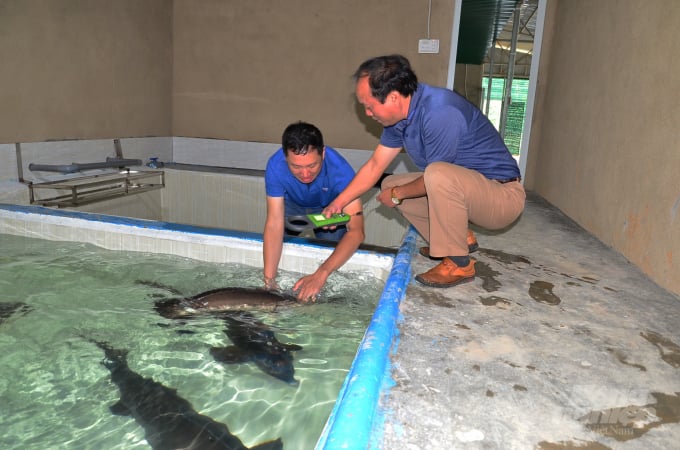
Catching sturgeon in the artificial winter house to read chips and check parameters. Photo: Minh Hau.
Listed in the Red Book, sturgeon can be found in many countries, but the most famous location is in Russia. One kilogram of Siberian sturgeon caviar costs approximately USD1,000, Russian sturgeon is USD1,200, Beluga sturgeon is USD 5,000 - 10,000. The most precious is white sturgeon, which price is as expensive as pure gold. The crime of smuggling natural sturgeon eggs is handled very seriously, even at the cost of life. Only cultivated eggs are allowed to be commercialized, but they require a circulation permit.
Vietnam allows farming for five species of sturgeon, four of which are from Russia and one from China. There are a few units that raise sturgeon for food at the moment such as Sun Dale JV., LTD - a joint venture with Russia, and Vietnam Sturgeon Group. As for producing eggs for breeding, only Dr. Thuy's farm is the most successful.
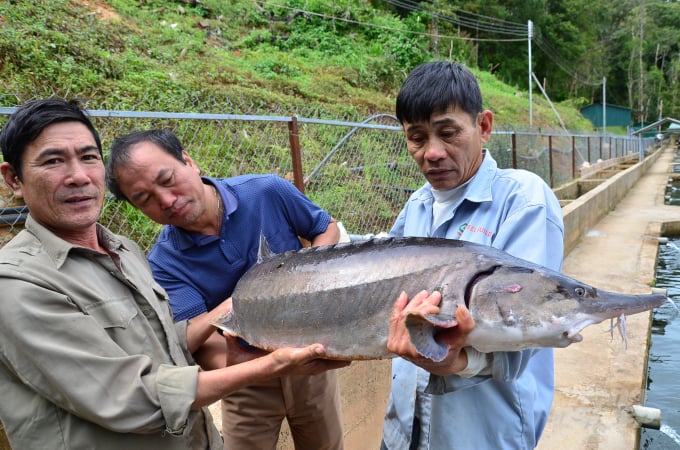
Dr. Nguyen Viet Thuy (middle) checking the sturgeon parents. Photo: Duong Dinh Tuong.
I entered the artificial winter house, reached into the water tank to raise a sturgeon carrying eggs for a few seconds of photos, but my skin soon went unbearably numb. And when I pulled my hands up, it turned red like suffering a cold burn. Dr. Thuy laughed and told me to imagine this is the bottom of the Volga river having a thick 1.5m layer of ice on the surface.
When asked about the reason for artificial winter, Dr. Thuy explained, “In Russia, winter begins in October. In November there will be snow and at the end of November the Volga river freezes. Although the top is covered by a layer of ice 1.5 - 2m thick, the water is still flowing at the bottom of the river with a temperature of about 4 - 5 oC. That’s where the sturgeon lies. Through the spring, the snow melts, and the fishes become mature. In Lam Dong, the temperature is usually 18 - 20 oC, not enough coldness as the natural winter in Russia, so artificial winter must be made to simulate the familiar habitat of the fish. From the outside environment, ie the Volga River in the spring of relatively 18 oC, the air conditioning system will pull down 1 oC every day until the water reaches 5 oC. This means it takes 13 days for the fish to cope with the temperature and then be reared for about one month. After that the temperature will be raised 1 oC per day again, to 13-14 oC for the fighter to stimulate birth.”
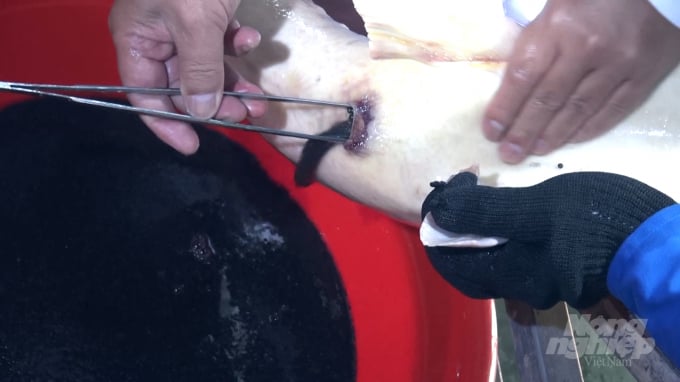
Collecting sturgeon eggs to prepare for artificial insemination.
This time, there are 14 sturgeon in such an artificial winter zone, including the two Siberian and Russian varieties. The ovary of the sturgeon may previously contain old and young eggs, but after undergoing artificial wintering, the overall status of the eggs is relatively even, suitable for injection of reproductive stimulants.
According to Mr. Thuy, making eggs for breeding was much more difficult than making commercial eggs. “Making commercial products only requires an ultrasound, poke the dipstick in and see. If there are eggs, you will hit the fish's head, peck it, take the eggs out and process it, and the fish will die. As for the eggs for breeding, after ultrasound you have to inject hormones into the fish, remove the eggs while keeping the fish alive, then wait for more than 1 year until the new spawning season.”
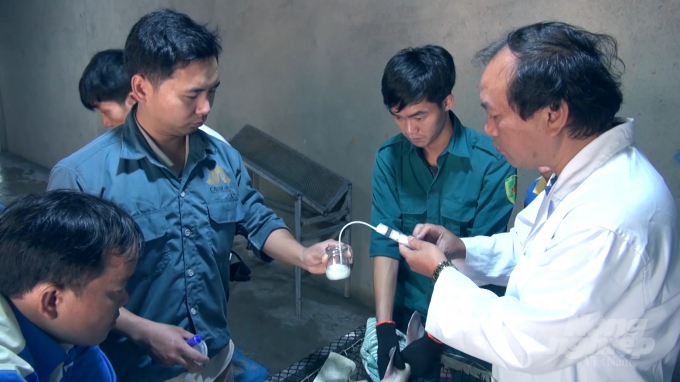
Dr. Thuy (white shirt) is sucking sperm from male sturgeon to prepare for artificial insemination.
For each extraction operation, in addition to the "doctor" who is Dr. Thuy, there must be a few assistants: one carries water, and one de-sticks the eggs to prevent them from clumping into a lump when leaving the mother's body and thus causing death. The semen is mixed with a certain ratio of water. For every kilogram of eggs, there is a specific ratio with how many cc of semen and how many liters of water are needed.
As for the male fish, when taking the semen, there is no need to make an incision, but only a syringe to suck. You can collect 100 cc of semen for each fish weighing 15-20 kg, enough to fertilize 5 females, but to ensure biodiversity, Dr. Thuy mix the sperm of three males to fertilize one female to avoid inbreeding condition. Not all male fish’s sperm can be used. They must be examined with a magnifying glass to see whether they are strongly active or not.
"Because fish sperm contains water, if preserved with liquid nitrogen, that water will turn into thousands and thousands of thin, tiny sharp blades that cut off the tail of the "tadpole", rendering them immobile. Therefore, additives must be added to prevent that from happening. It is a proprietary technology of Russia, so in the next few days there will be three experts coming to transfer this technology to my fish farm. They say that the sperm preserved in nitrogen is very good, but I still have to try and compare it with the fresh one to see and compare in full detail," said Dr. Thuy.
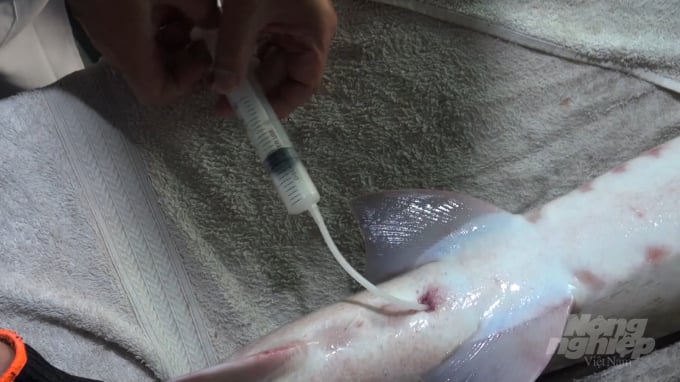
Close-up of the process of extracting sperm from male sturgeon for artificial insemination.
“The fertilization rate of 75 - 80% and hatching rate of 70% is already considered a complete success. There are units that import a lot of sturgeon eggs but produce very few fingerlings because of poor technology.” The important thing is that Dr. Thuy currently does not have a school of female fish that give good eggs after an abundant spawn. Averagely every 1 - 1.5 months the team will perform cesarean on approximately 10 fish like that.
Dr. Thuy's facility has 1,700 broodstock, and it is expected that when the spawn is abundant they will be less dependent on imports, saving foreign currency for the country.
To be continued...
Translated by Samuel Pham
![Turning wind and rain into action: [9] Digitizing hydrometeorological data in response to climate change](https://t.ex-cdn.com/nongnghiepmoitruong.vn/608w/files/news/2025/06/17/z6704423696987_15fd32ffc26d590d204d520c9dac6786-nongnghiep-165943.jpg)
(VAN) Farmers have begun accessing hydrometeorological applications to adjust their cropping schedules, aiming to ensure productivity and adapt to climate change.
![Turning wind and rain into action: [8] Real-time salinity detection and early warning technology](https://t.ex-cdn.com/nongnghiepmoitruong.vn/608w/files/news/2025/06/17/z6704423696987_15fd32ffc26d590d204d520c9dac6786-nongnghiep-151127.jpg)
(VAN) Thanks to the integration of modern hydrological-hydraulic models, remote sensing technologies, and artificial intelligence, the accuracy of hydrological forecasting has significantly improved.
![Turning wind and rain into action: [7] Early disaster warnings help marine farmers minimize losses](https://t.ex-cdn.com/nongnghiepmoitruong.vn/608w/files/news/2025/06/17/z6704423696987_15fd32ffc26d590d204d520c9dac6786-nongnghiep-142942.jpg)
(VAN) In recent years, thanks to early disaster warnings and forecasting, marine farmers in Khanh Hoa province have been able to reduce risks and losses, thereby improving production efficiency.
![Turning wind and rain into action: [6] ‘Four on-the-spot’ disaster management software](https://t.ex-cdn.com/nongnghiepmoitruong.vn/608w/files/news/2025/06/17/e5a48259d6a262fc3bb3-nongnghiep-183800.jpg)
(VAN) By simply activating the scenario on the disaster management software, the relevant authorities immediately know how many households need to be evacuated, where to evacuate them to, and by what means of transportation…
![Turning wind and rain into action: [5] Hue applies modern technology in disaster forecasting](https://t.ex-cdn.com/nongnghiepmoitruong.vn/608w/files/news/2025/06/17/z6704423696987_15fd32ffc26d590d204d520c9dac6786-nongnghiep-093938.jpg)
(VAN) In Hue city, modern technology has recently been applied in meteorological and hydrological forecasting and warning, helping to reduce the damage caused by natural disasters.

(VAN) A cutting-edge farming technique being implemented on an experimental ranch in Arizona's Sonoran Desert has already saved a billion gallons of water over five years, according to Civil Eats.

(VAN) Poultry and pig production and the environment can be boosted through enhanced water technology, according to new research.